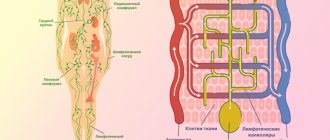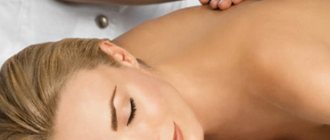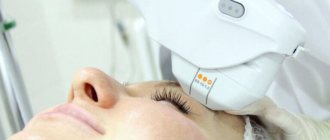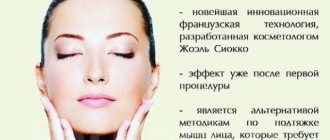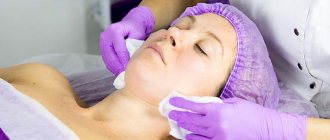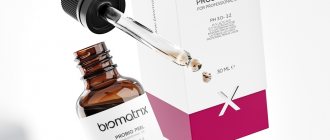What is Lymphatic Drainage of the Body?
Lymphatic drainage is used as a therapeutic, restorative, physiotherapeutic, restorative and cosmetic procedure. Depending on the indications, this type of massage is carried out as a course or as a preventive measure regularly - once a week. This type of procedure refers to osteopathic and manual techniques of influencing the body, and experienced osteopathic doctors handle this manipulation most professionally and competently. Despite the fact that many patients resort to this manipulation solely for aesthetic purposes, it is more of a medical procedure than a cosmetic one.
Features and functions of the lymphatic system
Lymphatic drainage is based on practical knowledge of the anatomical and physiological processes occurring in the human body. The lymphatic system is a section of the body’s vascular system, which, along with blood, ensures the supply of nutrients to cells, provides immune protection, the ability to resist pathogenic influences (infections, viruses) and the aging process by cleansing tissues.
Like the circulatory system, the lymphatic system has its own capillaries, pathways, trunks, vessels, and ducts. Through capillaries, metabolic processes take place, the absorption of liquids with solutions of proteins, products of breakdown and vital activity of cells, and foreign particles from the intercellular spaces. Thanks to the movement of lymph, water with substances dissolved in it is transported and tissues are drained. This process ensures the maintenance of a constant water balance in cells and tissues.
In addition to ensuring the outflow of fluid from the tissues of the whole body, lymph produces:
- delivery of hormones from the endocrine glands, here the lymphatic system acts as one of the participants in metabolic processes;
- delivery of lymphocytes from lymph nodes to organs and tissues, which ensures the immune function of the body;
- transport of lipids (emulsified fats) from the small intestine into the venous system as part of the cleansing process.
Lymph is similar in composition to blood plasma; it contains proteins, glucose, and minerals. The thicker the lymph, the lower the rate of lymph drainage. On average, it is about 120 ml per day, and in an active state of wakefulness, lymph moves faster and slows down during sleep. This is often the cause of morning puffiness and circles under the eyes.
Slowing down lymph flow leads to a number of negative consequences associated with disruption of metabolic and immune processes, accumulation of excess fluid in connective and intercellular tissue, intoxication of the body with decay products, infections and harmful substances. Often, lymph retention and slow lymph drainage are one of the causes of excess weight and the formation of cellulite.
The composition, and therefore the speed of movement of lymph, depends on many factors - lifestyle, sleep and wakefulness, diet and regularity of nutrition. When a person leads a sedentary lifestyle, eats large amounts of fats and animal proteins, lymph stagnation occurs. Prolonged stagnation of lymph provokes many disorders in the functioning of internal organs and has a negative impact on almost all vital functions. That is why lymphatic drainage of the body is one of the most accessible health procedures that can be used to influence both individual areas of the body and the entire body as a whole.
Consequences of lymphatic system dysfunction
Considering that the lymphatic system takes part in the most important processes of the body, its dysfunction disrupts metabolism and immunity, which can lead to various diseases.
Most dysfunctions are caused by lymph stagnation, during which dangerous microorganisms, defective cells, and toxins accumulate in the body, causing various infectious, inflammatory and oncological diseases, including cancer.
Stagnant and accumulating intercellular fluid causes serious edema, including elephantiasis.
Since the lymphatic system does not have its own pump, like the circulatory system, the movement of lymph is ensured by contractions of muscle tissue. With age, most people lead a sedentary lifestyle and gain excess weight, which impairs the movement of lymph through the vessels and causes lymphostasis.
That is why it is so important to keep the lymphatic system in good shape, especially during the period of natural decline of the functions of the thymus gland, which begins after 20-25 years. Effectively prevents dysfunction of the lymphatic system and prevents associated pathologies of lymphatic drainage of the body.
Technique for performing lymphatic drainage procedure
Lymphatic drainage according to method and technique is divided into two types:
- Hardware lymphatic drainage of the body is a massage procedure performed using special medical (cosmetology) equipment. The most effective and popular hardware massage techniques are the vacuum method and microcurrent therapy. In addition to the use of various technological devices, hardware lymphatic drainage is classified according to the depth of impact on superficial and internal massage.
- Manual lymphatic drainage is a manual technique performed exclusively by the hands of a specialist. The effectiveness and therapeutic effects of manual massage directly depend on the professional knowledge, skills and skill of the doctor who performs this procedure.
Hardware lymphatic drainage
Vacuum lymphatic drainage is mainly performed to target problem areas in order to reduce fat deposits and improve skin tone. According to the technology, the vacuum effect extends to the dermis of the skin and subcutaneous fatty tissue. During vacuum massage, the skin and superficial subcutaneous layers are drained, after which fluid from the tissues enters the lymphatic vessels and is drained naturally.
Hardware body massage using the vacuum method is more of a cosmetic manipulation aimed at eliminating the manifestations of cellulite and combating excess weight, as it has a targeted effect and limited depth. With the help of such manipulation, it is possible to improve the circulation of lymph and blood in the surface layers of the skin and epidermis, which, with a systematic approach, guarantees a decrease in the volume of fat deposits, improvement of skin tone and color by stimulating metabolic processes, activating blood circulation and eliminating chronic stagnation of fluid in tissues.
The duration of one procedure varies from 30 to 60 minutes depending on the indications and individual characteristics of the patient. The most noticeable impact of the body lymphatic drainage procedure using a vacuum apparatus is felt during a course of 10 sessions. It is this approach that guarantees powerful cleansing of the skin and subcutaneous layers from water, toxins and pathogenic microorganisms accumulated in the intercellular space during lymph stagnation.
However, it is worth noting that vacuum massage has some contraindications and before carrying out the procedure, consultation with an osteopath, attending physician (in the presence of chronic diseases) or a therapist is necessary. If a person has very sensitive skin that is prone to damage, lymphatic drainage using the vacuum method can cause capillary injuries and the formation of subcutaneous hematomas of varying severity.
Lymphatic drainage massage of arms, chest, abdomen, legs
Indications for performing lymphatic drainage massage of the hands are any operations on the mammary gland, in the armpit area. Inviting the patient to stretch his arm in front of him, the massage therapist slowly strokes it with his fingers from the wrist to the elbow joint. Circular strokes with the palm are performed on the shoulder - from the elbow to the armpits. After completing at least ten circles, move on to massaging the other hand. The final stage is rubbing the brushes. Stroking is carried out from the fingertips to the wrists. To disperse lymph in the palm, use the thumb.
Lymphatic drainage of the abdomen is performed in a circle. At the initial stage, the massage therapist, with careful movements allowing slight vibration, presses the muscles in the area of the projection of the liver and gall bladder. After this, light pressure is applied to the location of the pancreas. It can provoke rumbling in the patient coming from the abdominal cavity. The next stage of abdominal massage is the impact on the left and right iliac region. It is aimed at improving the condition of the large intestine. Lymphatic drainage of the stomach and spleen is carried out by intermittent light vibration.
Lymphatic drainage of the legs is performed after surging. Blood flow is improved with stroking, kneading and squeezing movements. Strokes can be spiral, zigzag and straight. They are performed in the direction from bottom to top, from the knee to the hip joint, along the inner and outer surface of the thigh. 6-7 movements of each type are enough.
To perform push-ups, use the inner edge of the palm and ridges, which are obtained by clenching your fingers into a fist. With energetic, painless movements directed from the knees to the groin area and to the hip joints, the massage therapist rubs the thighs. Repeat both types of push-ups at least six times. At the kneading stage, specialists at the Yusupov Hospital use many massage techniques. Kneading can be circular, transverse and longitudinal. At this stage of lymphatic drainage massage, the felting technique is used. The massage therapist performs movements from bottom to top. Massaging the legs is carried out exclusively from the back side, stroking from the ankle joints to the popliteal fossae. To perform vigorous push-ups, she uses the grasping technique. When kneading, it does not cause intense stretching of the skin. Lymphatic drainage massage of the back can relieve the patient of stress and muscle pain.
Hardware lymphatic drainage using pressotherapy method
Pressotherapy is a physiotherapeutic method of influence, which is carried out using a special compressor worn over the whole body. The compressor consists of individual cuffs that are inflated one by one, squeezing soft tissue and directing the outflow of venous blood and lymph. The entire process is automated; the specialist only needs to correctly position the compressor and control the sequential activation of individual compartments.
This type of lymphatic drainage helps direct the movement of lymph along natural outflow pathways, which eliminates fluid accumulation and stagnation in tissues. In addition to influencing the vessels and channels of the lymphatic system, the pressotherapy procedure stimulates the lymph nodes, which has a beneficial effect on the immune system, tones the body and increases its protective mechanisms.
Hardware lymphatic drainage using electric current
In medical osteopathic and cosmetology practice, several types of electrical effects on lymph are used. The most effective methods include:
- Electrical stimulation is a method of influencing soft tissues of the body and muscles with pulsed current. This type of therapy is used for a number of diseases that are accompanied by weakening or atrophy of muscle tissue, congestion and swelling. The technique operates on the principle of a muscle pump; electrical impulses cause smooth muscles to contract rhythmically, thereby accelerating the movement of fluids - lymph and blood. In addition, in addition to increasing the rate of lymphatic drainage, the lymph nodes are stimulated.
- Microcurrent lymphatic drainage is a therapeutic technique that allows you to influence skin cells, blood and lymphatic vessels. The principle of operation is similar to electrical stimulation with the difference that in this case extremely small currents are used. The method is widely used in cosmetology, since it can be used to stimulate metabolic processes at the cellular level.
How to avoid possible complications
Complications may appear if all contraindications are not taken into account. Also, if done incorrectly, redness or swelling may occur. In order to avoid these and other possible consequences, the specialist must monitor the patient’s condition and reaction. If you do self-massage, then be even more attentive and careful.
We constantly repeat that massage should be performed strictly along massage lines. If you do it against the massage lines, gather the skin into folds, press hard on the skin while stroking - all these actions lead to the formation of additional wrinkles and ptosis (drooping) of the skin, especially in the area of the nasolabial triangle.
Manual lymphatic drainage
The method of osteopathic and manual influence on all parts of the body in turn is highly effective in treating a number of diseases and disorders in the functioning of internal organs and functional systems of the body. This method cannot be classified as a very common procedure, for several reasons.
This is primarily due to the fact that manual lymphatic drainage must be carried out by an experienced and highly qualified specialist with professional knowledge of the anatomical structure of the body in general and specifically the lymphatic system. When working with a patient, an osteopathic doctor takes into account a lot of nuances, from the nature of existing disorders and general health, to the speed of lymphatic drainage and the individual characteristics of the body.
A qualified osteopath is distinguished by very high sensitivity of his fingers, thanks to which he can feel any pathological changes in soft tissues when touching and working deeply. Based on the nature of the seals, muscle tension, the condition of the skin and subcutaneous tissue, the doctor can not only determine the nature of functional and anatomical disorders, but also influence certain organs and areas of the body.
Osteopathic lymphatic drainage of the body is a purely individual process, so the duration and number of sessions can only be discussed approximately. As a rule, a general massage, which includes working on the whole body and face, takes about one and a half hours and consists of various techniques.
Expected results
It is not surprising that many people ask the question of what to expect from lymphatic drainage massage. After a certain number of procedures, the skin color noticeably improves, it becomes toned and velvety. Bags and dark circles under the eyes disappear, you will look refreshed and rested.
It is clear that a one-time procedure will not give a positive effect. It is recommended to do massage in courses: 8-12 procedures. You can achieve the desired result faster by incorporating other methods of healing and cleansing the body. After 2-3 months, lymphatic drainage massage should be repeated.
Indications and contraindications for lymphatic drainage
Indications for a course of lymphatic drainage are the following factors:
- Tendency to swelling of soft tissues and face, imbalance of water-lithium balance, provoked by pathologies of the cardiovascular or urinary system, hormonal disorders, allergies or liver diseases.
- Varicose veins and signs of congestion in the lower extremities.
- Excess weight, varying degrees of obesity, manifestations of cellulite.
- Feeling of heaviness in the limbs.
- Skin problems and diseases caused by metabolic disorders and hormonal diseases (menopause).
- Chronic fatigue, impotence, decreased body tone as a result of overwork, stress or after illness.
- Decreased immunity, frequent colds and viral diseases, allergies.
Lymphatic drainage is contraindicated in the presence of the following pathologies:
- thrombophlebitis in the acute stage;
- renal failure;
- tumor diseases;
- diabetes;
- hematopoietic diseases;
- infectious diseases of any etiology.
Electrical influences are not allowed in case of individual intolerance to current. Lymphatic drainage is not performed during pregnancy, lactation and menstruation. For any medical or cosmetic indication, any type of procedure (hardware or manual) should not be performed without first consulting a physician.
